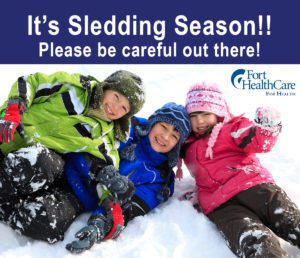December 13, 2018
Preparing young sledders for the season

It’s sledding season!
Sledding is a winter tradition that seems pretty straightforward, right? You go to the top of a hill, sit on a sled and enjoy the fresh air on your face as you glide down. But, if you have ever been fallen off a sled mid-hill or endured a crash landing, you know that sledding is not always smooth…or safe.
Each year, as many as 20,000 emergency room visits are a direct result of sledding accidents.1 The most common injuries are bruises, cuts and broken bones, but head and neck injuries are common among children 6 years old and younger.2
For a younger child, going down a hill at 20 miles per hour can be hard to manage. Before you go sledding this year, equip younger sledders with some sledding know-how. The following tips will help you create a safer sledding experience for the younger sledders in your group.
Choosing the right sled
Just because you can use something as a sled doesn’t mean you should! First things first, use a sled that’s meant for sledding. For the safest sledding, look for sleds that can be steered and have brakes to help you slow down. Also, pay attention to the sled’s weight limit, to how many people the sled is meant to hold and that the sled is free of sharp or jagged edges.
Choosing the right hill
Not all hills were meant for sledding. When finding a good sledding hill:
- Find a hill that has a long flat area at the bottom, so there is time to glide to a stop.
- Avoid hills that are too steep because the steeper the hill, the faster the speed going down. At fast speeds, it is harder to stop, harder to steer and more dangerous if you fall off.
- Avoid hills that end near a street (for obvious reasons) or a parking lot.
- Avoid sledding near or on frozen ponds, streams, or lakes in case the ice is not strong enough.
- Look for hills that are free from obstacles you might hit while sledding, including fences, trees, rocks, and poles.
- Avoid hills with jumps or bumps. Going over bumps or jumps at fast speeds can increase the chances of falling off of sleds or landing hard.
- Find hills that are less populated. The more people sledding, the more chances there are for collisions.
Sledding techniques for young sledders
Be sure to talk through a few sledding techniques with young sledders before they begin:
- Always ride feet first and facing forward. Going down head first or backward increases their risk of injury and reduces their ability to steer or stop the sled safely.
- Show riders how to use feet safely to slow the sled.
- Remind sledders that if they cannot slow down, are going to hit a bump, or are about to hit an obstacle (like a tree), they should roll off the sled to the side, instead of crashing.
Dressing for the occasion
You may not classify sledding as a winter sport, but concussions and frostbite are real possibilities. So, treat it as such. Always wear a helmet. Dress in layers so you can easily remove or add clothing as you adjust to the temperature. Wear waterproof winter wear so that your clothes do not get wet and start to freeze. If your clothes do get wet, be sure to change into dry clothes or go to a warm place until your clothes are dry.
Sledding Etiquette
Even if you are sledding in your backyard, it’s more fun (and much safer) to sled with others. And, it’s more fun (and safer) if everyone follows a few rules:
- Go down the hill one at a time.
- Wait until the sledder in front of you is at the bottom of the hill to begin your turn.
- Slide down the middle of the hill. Climb back up the hill on the sides.
- At the bottom of the hill, be sure to move out of the way quickly so that you do not get hit by the next sled.
Slower is sometimes better…
For young sledders, going too fast can be scary and uncomfortable (especially if it ends in injury!) To make the experience a good one, find hills with less slope where there are no bumps or jumps added. Choose hills that are snowy rather than icy. If hills have become icy, they can make falls more painful and can make sled control more difficult. And, finally, look for areas with other young sledders so that you can take your time and go at your own pace.
There’s no doubt that sledding is one of the perks of Wisconsin winters! This year, make it a safer experience for sledders of all ages!
Sources:
- Slippery Slope: Take Care to Prevent Sledding Injuries. www.nsc.org/home-safety/tools-resources/seasonal-safety/winter/sledding
- Sledding Safety. www.nationwidechildrens.org/research/areas-of-research/center-for-injury-research-and-policy/injury-topics/sports-recreation/sledding-safety
